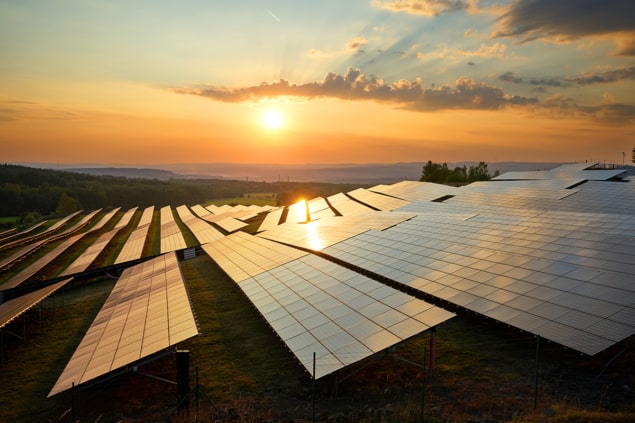
A new report by LUT University in Finland and the Energy Watch Group (EWG) in Germany outlines a cross-sector, global 100% renewable energy system, backing up the version it released last year. The full modelling study simulates a total global energy transition in the electricity, heat, transport and desalination sectors by 2050. It claims that a transition to 100% renewable energy would lead to a system that was economically competitive with the current fossil and nuclear-based system. It could also, the study says, reduce greenhouse gas emissions in the energy system to zero by 2050, or perhaps earlier, without relying on negative CO2 emission technologies.
LUT/EWG have also developed a range of national roadmaps for the transition to 100% renewable power. The new global 100% renewable study builds on that work, and earlier global studies, covering all sectors.

Global energy challenges: is there room for growth?
“The study’s results show that all countries can and should accelerate the current Paris Climate Agreement targets,” said Christian Breyer, professor for solar economy at LUT. “A transition to 100% clean, renewable energies is highly realistic – even today, with the technologies currently available.”
Hans-Josef Fell, former member of the German Parliament and president of the Energy Watch Group, added: “The report confirms that a transition to 100% renewables is possible across all sectors, and is no longer more expensive than the current energy system. It shows that the whole world can make the transition to a zero emission energy system. That is why all political powers around the world can and should do much more to protect our climate than they currently envision.”
The study’s key findings include:
- The transition to 100% renewable energy requires comprehensive electrification in all energy sectors. The total electricity generation will be four to five times higher than electricity generation in 2015. Accordingly, electricity consumption in 2050 will account for more than 90% of the primary energy consumption. At the same time, consumption of fossil and nuclear energy resources in all sectors will cease completely.
- The global primary energy generation in the 100% renewable energy system will consist of the following mix of energy sources: solar energy (69%), wind power (18%), hydro (3%), bioenergy (6%) and geothermal energy (2%).
- By 2050, wind and solar will account for 96% of the total power supply of renewable sources, produced virtually exclusively from decentralised local and regional generation.
- 100% renewables are more cost-effective: the energy costs for a fully sustainable energy system will decrease from € 54/MWh in 2015 to € 53/MWh in 2050.
- The transition in all sectors will reduce the annual greenhouse gas emissions in the energy sector from roughly 30 Gt CO2-equivalent in 2015 to zero by 2050.
- A 100%-renewable electricity system will employ 35 million people worldwide. The roughly 9 million jobs in the worldwide coal mining sector from 2015 will be phased out completely by 2050. They will be overcompensated by the over 15 million new jobs in the renewable energy sector.
The study concludes with political recommendations for a rapid integration of renewable energy and zero greenhouse gas emission technologies. Among the most important measures suggested are promoting sector coupling, private investments –which should ideally be incentivised with fixed feed-in tariffs, tax breaks and legal privileges with simultaneous discontinuation of subsidies for coal and fossil fuels. According to the report, the transition to a global energy system based on 100% renewables can be achieved before 2050 if a strong policy framework is implemented.
Radical agenda
This version of the LUT/EWG work was offered in support of the ongoing Fridays For Future movement initiated by young climate activist Greta Thunberg. In the foreword, Fell says that should “serve as a wake-up call for all of us to collectively do our best to hand over our planet to the next generation in the best condition possible”. We need to radically change the status quo in which we have put our planet and our children, who are “threatened by the challenges of climate change, air pollution, nuclear threats, conflicts over resources, poverty and refugee crises”, he adds. “With the scientific findings and elaborated set of policy measures of this study, we have developed a roadmap to achieve what our young generation calls for with great dedication and courage.”

Views differ on renewable energy futures
The report certainly is very ambitious with, for example, photovoltaic (PV) solar expanding dramatically to supply 69% of primary energy by 2050 from a truly massive 63.4 TW. That is hard to imagine, given that PV is under 500 GW at present, but with PV system costs continually falling, rapid expansion is certainly very likely. The LUT/EWG report looks to wind playing the main role earlier on and PV then accelerating to around a 32% share of power generation by 2030 and to 73% by 2050. Whether that is credible remains to be seen. Other studies have been more cautious. One earlier 100% scenario from Jacobson et al had PV at around 6.8 TW by 2050 and another projected over 10 TW as possible, while yet another had 15 TW of PV installed by 2050. An earlier LUT/EWG scenario, just for the power sector, put it at around 22 TW. Cost falls since then might justify higher projections, and the 63.4 TW is for supplying all sectors but it is definitely pushing it to the maximum. It seems to be one result of opting for a heavily electricity-based system – for power, heat and transport. Arguably, a scenario in which non-electric renewables such as solar heat and biomass played more of a role might reduce the need for so much PV. But LUT/EWG are keen to avoid the widespread use of biomass and biofuels, while solar thermal heat only supplies 5% of primary energy in its 2050 scenario. Basically, on the basis of their cost analysis, LUT and EWG see PV solar, with cheap batteries, carrying all before it.
Leaving that issue aside, the proposals for balancing the large variable renewable inputs look reasonably credible, with energy storage meeting nearly 23% of electricity demand and approximately 26% of heat demand. Given that a key issue is meeting the relatively short periods of peak demand, that, along with other flexibility measures, may suffice. In the LUT/EWG mix, in addition to batteries for short-term storage, use is made for overall balancing and longer periods of “Power to Gas” (P2G) electrolytic conversion of surplus renewable output to storable hydrogen, along with methanisation, an approach being developed in Germany. Heat pumps are also widely used, along with bioenergy-fired combined heat and power (CHP) and extensive heat storage, offering further flexibility. In terms of transport, wide use is made of synthetic vehicle fuels and direct electricity, squeezing fossil fuel out entirely by 2050.
Positive visions
The devil, of course, is in the detail. There is plenty in the report for modellers to get stuck into, although it is just modelling — not as yet a detailed programme for developing the necessary systems in reality. However, modelling exercises like this do highlight some of the issues ahead and provide at least some confidence that ambitious plans might be technically possible — and economically viable — given the political will. Whether we could actually do it remains to be seen, with many technical issues still to be considered. Whether we will try also remains to be seen. But it is clear that something has to be done. This scenario maps out what is arguably one possible direction forward, as does a new study by Wärtsilä that laid out what might be done to balance 100% renewables, with inflexible generation being phased out and P2G taking over.
Mark Jacobson at Stanford University, meanwhile, is upgrading his group’s 100% all energy global scenario, with a new book out soon. The online extracts look very radical. Jacobson too sees no role for nuclear or carbon capture and storage (CCS) or direct air carbon capture and storage (DACCS) and even less of a role for biomass, but wind plays a bit more of a role than in the LUT/EWG scenario — although overall demand is reduced much more. Plenty to get stuck into.
The basic underlying “opportunity cost” argument used by both Jacobson and LUT/EWG is that the low and falling cost of renewables ensures that a fixed amount of capital spent on them reduces carbon dioxide and air pollution more than if the same money were spent on any of the other technologies. But, as ever, not everyone agrees and the debate over renewable system costs, and indeed technical viability, goes on. As my next post illustrates, in the case of grid-scale energy storage.



